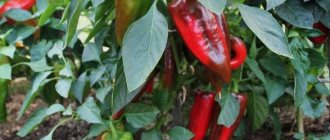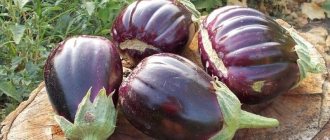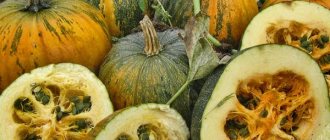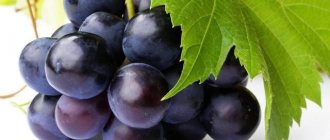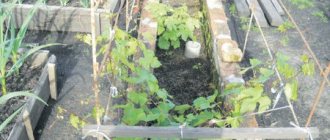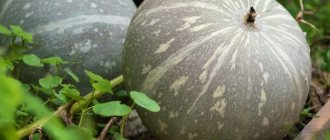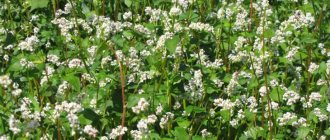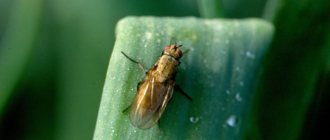Pumpkin Pearl: description of the variety
The plant has very long vines. Pearl is a strong shrub with a trunk reaching a height of 70 to 100 cm. From 5 to 7 shoots are formed on the sides of the trunk. Each shoot has ovaries, most often in the singular.
The leaves are medium in size and dark green in color. There are barely noticeable white specks on the leaves. The leaf blade has the shape of a pentagon and is not dissected. The surface is covered with slight fluff.
Pumpkin Pearl - photo
Male and female flowers are formed on the plant at the same time. When the bees have pollinated the flowers, ovaries appear on the female flowers. The flowers are large in size, rich yellow in color and have 5 petals.
Note to the gardener!
Bushes of the Pearl pumpkin variety have such a strong and powerful root system that it can reach a length of 3 to 4 meters.
The nutmeg pumpkin variety Zhemchuzhina is recommended for cultivation in the regions
:
- Ural;
- North Caucasus;
- Far Eastern.
Characteristics of the variety
The Muscat variety Zhemchuzhina is medium late; the pumpkin can be harvested after 100-110 days, more often after 115-130 days.
Good resistance to winter and drought is observed. Harvest only in dry weather.
The tail should be left when the fruit is broken. The pumpkin should stay in the sun for 3-4 days, and only then is it ready to eat.
If everything is done correctly, the fruits will be easy to transport. Storage can last up to six months, then they lose their taste.
This variety cannot be stored in the basement; only a dry and bright place will do.
External description
An ordinary pumpkin bush forms 4-7 vines with large dark green leaves, on which white spots are observed. The leaf is whole, not dissected, and has a pentagonal shape.
The fruits are completely round or oval, with a ribbed structure. They are impressive in size, weighing 7-8 kg per one. They reach 50 cm in length. Despite these parameters, the seed nest is small and located at the bottom.
According to the description, the Pearl is very tasty and juicy, the structure of the pumpkin pulp is fibrous.
It contains a high percentage of carotene, which is why the fruit has a rich orange peel and pulp color. When ripe it is grayish-green in color.
Description of fruits
Pumpkins within a variety may differ in shape, size, and color. What the fruit looks like depends solely on the manufacturer of the seeds for planting.
Most often you can find Pearl pumpkins of large sizes, shaped like a cylinder.
. Externally, these fruits are similar to zucchini. In the upper part there is a thickening in the shape of an oval or circle. There is a small nest here that contains seeds.
Pearl fruits can have a smooth surface and can be divided into separate segments. The length size, most often, ranges from 45 to 55 cm. The weight of a ripe fruit varies from 4 to 7 kg.
In some cases it reaches 8 kg.
The skin of the fruit is thin and elastic. When ripe, the pumpkin turns orange and green or just a deep orange hue. Sometimes the fruits have a pattern in the form of a fine mesh.
The pulp of the nutmeg pumpkin fruit is tasty, juicy, and has a pleasant pumpkin aroma.
. The color is dark orange. Many vegetable growers speak of this variety as the most delicious of all existing ones.
Good to know!
The high content of carotene, pectin and mineral salts increases the value of the pumpkin fruit. In addition, the composition contains vitamins (groups B, PP, E, K) and provitamin A. Perfect for feeding those who are on a diet.
Pearl – table variety
. Its fruits are suitable for fresh consumption (for example, in juices), as well as processed, for baking. A great option is freezing. It is in this form that the greatest amount of nutrients and beneficial substances are preserved.
How many of you have grown or are growing pumpkins and what varieties?
Natali Mur)
I planted Nutmeg Pearl, Volzhskaya gray and Hazelnut last year from Volzhskaya, I want to give up, I prefer smaller pumpkins and it is more convenient to store and transport.
Offer
Growing pumpkins requires good watering all the time, and then they will grow big and tasty. It is better to grow pumpkins that are not large in size. If you decide to specifically learn about growing pumpkins, then the article https://domashneehozaistvo.ru/vyrashhivanie-tykvy will help you with this
Sergiy
I tried a lot, but settled on the nutmeg pearl. The taste is super!! ! Although it is late, it is long-growing and cannot be stored for a long time. I continue to try other varieties. This year I’ll try the smile, baby, golden pear, I think it’s called.
Luda Vysotskaya
I grew a bunch of varieties. Now only honey and gymnosperms. Yes zucchini for early consumption. It seems to me that nutmeg and honey are the same thing.
Margot
Delicious Pumpkin Peanut Butter. It’s small, pear-shaped, there are few seeds, there’s a lot of pulp, it stores well, the skin is thin and can be cut with a knife, and most importantly, it’s sooooo sweet.
- Photo growing pumpkin
- Pumpkin Growing Forum
- Growing pumpkin in Donbass
- How and when to plant pumpkins
- Pumpkin seeds for seedlings
- How to grow a good pumpkin
- Sow pumpkin
- Soaking pumpkin
- At what distance should pumpkins be planted?
- When and how to collect pumpkin
- Pumpkin care video
- What can you plant pumpkin with?
- Caring for pumpkins in open ground
- Pumpkin care
- What to plant after pumpkin
- Caring for pumpkins in open ground
Resistance of Pearl pumpkin to pests and diseases
Pumpkin varieties Zhemchuzhina are characterized by the same diseases that are characteristic of most melons.
The most common pumpkin diseases
:
- anthracnose;
- root rot;
- powdery mildew;
- Fusarium wilt.
The main prevention against the occurrence of diseases is the mandatory treatment of pumpkin seeds before sowing, as well as the mandatory observance of crop rotation.
Pumpkin variety!
Pumpkin Smile
Among the pests, the Pearl pumpkin can be affected by: melon aphids, spider mites, and mole crickets.
Attention!
Synthetic drugs are often used to eliminate insects. Non-traditional means are no less effective, such as treating affected plants with a soap solution or ash diluted in water.
Culinary use
Interestingly, nutmeg varieties are not the sweetest among pumpkins. They accumulate 5 - 6% sugar, and record varieties of large-fruited pumpkin - from 8 to 13%. But the spicy aroma and delicate consistency of the pulp make the “nutmeg” more tasty.
Many of them can be eaten raw, like fruit.
And they should be cooked more like fruits than vegetables. The pulp is put into porridge and fruit salads, it is used as a filling for sweet pies, and a thick juice is obtained. The preparations are also excellent – jams, marinades, candied fruits.
@Joe Spake, flickr
The nutritional value
Butternut squash is a delicious and nutritious vegetable with medicinal properties. The benefits are determined by two main factors - the ability to be stored for a long time and the abundance of carotene. Shelf life of nutmeg pumpkin varieties indoors:
- from 3 months (Augustina, Guitar, Maria, Honey Tale, Chamomile)
- up to six months or more (Amati F1, Ariel F1, Penguin, Tsukatnaya, Chudo-Yudo).
When stored, the sweetness and aroma are enhanced, but the vitamins are not lost.
The pulp of most nutmeg varieties has a rich orange tint. This is a sign of a large number of carotenoids - provitamins of group A. They provide a person with healthy eyes, blood vessels and intestines. Minerals and phytosterols regulate the functioning of the liver and kidneys, as well as the production of hormones. The low calorie content (25 - 30 kcal) is also attractive.
The seeds are not as full-bodied as those of the large-fruited pumpkin, but they are also rich in microelements and omega acids.
Advantages and disadvantages
The pearl has both advantages and disadvantages.
The advantages of the Pearl pumpkin include:
:
- drought resistance;
- resistance to low temperatures;
- high taste characteristics;
- Pearl pumpkin has a pleasant aroma;
- the shape of the fruit is very convenient for storage and use;
- high pulp content due to small cavity for seeds;
- excellent ability to be stored for a long time;
- ability to transport over long distances.
There are no significant deficiencies in the variety
. Conventionally, we can distinguish: susceptibility to disease, the presence of peculiarities in relation to the composition of the soil, care, as well as a significant deterioration in taste properties during very long storage.
Suitable region and climate
Growing butternut squash requires a fairly warm climate. In the north of our country, this crop can only be grown in greenhouses. Do not forget that this vegetable came to us from southern countries.
If you plan to grow nutmeg pumpkin in our middle zone, choose varieties with early ripening. In this case, you will get a good, high harvest, and the pulp will have time to ripen, become juicy and sweet.
It is customary to pick the fruits when they are not yet fully ripe; it is necessary to have time to harvest them before frost sets in. So, in cool regions you need to harvest nutmeg pumpkin in mid-August, but the climate of the middle zone allows harvesting until mid-September. After harvesting, the pumpkins need to ripen - this takes, on average, a couple of months.
Pumpkin Pearl: growing variety
To obtain a good harvest, the creation of suitable favorable conditions will be required. When choosing the right place to plant the Pearl pumpkin, it should be illuminated from all sides, and the soil should be heated to a temperature of 10 to 12 degrees. In this case, the soil is preferably sandy loam or slightly loamy. The place must be protected from winds and drafts.
Photo of Pearl pumpkin
Preparing pumpkin seeds for planting
Before planting the seeds, they should be properly treated. To do this, prepare a saturated solution of potassium permanganate, soaking the seeds in it for 2 to 3 hours. For additional prevention, thoroughly dried planting seeds are treated with a fungicide.
Preparing a pumpkin bed
The beds are prepared in advance, for which the soil is moistened, loosened, and appropriate nutrients are added. Both organic and mineral fertilizers are poured to the bottom.
On a note!
If cucumbers grew at the site planned for planting, you do not need to apply additional fertilizing.
Planting holes for pumpkin crops are located at a distance of 1 to 1.5 meters from each other. It is important that the bushes do not interfere with each other. Maintain a distance of 1.5 meters between the beds.
Planting pumpkin seeds Pearl
Pearl pumpkin seeds are planted either at the very end of spring or at the beginning of summer. As a rule, at the beginning of June the earth is already warm enough. The sprouts feel good and begin to develop at temperatures from 18 to 25 degrees.
Planting pumpkins in open ground in spring
A pair of seeds is placed in the hole, placing them 5-6 cm deep into the soil. Sprinkle earth on top. The sprout must grow on its own.
Hardbark pumpkin
When ripe, the fruits of hard-rind pumpkin varieties form a very thick and hard crust. Typically, these pumpkins are low in sugar, have tasty seeds and early ripening. The best varieties of hard-barked pumpkin are Vesnushka, Altaiskaya, Almondnaya, Golosemyanka, Spaghetti, Acorn, Danae, Mozoleevskaya.
Freckle
Early ripe pumpkin for table use. Weight from 0.5 to 3 kg. The fruits have a medium-thick rind, green in color, and have yellow spots. The flesh of the Vesnushka variety resembles the taste of a pear, tender and sweetish. Has good keeping quality. Moisture-loving, susceptible to powdery mildew.
Almond
Canteen, feed, suitable for processing. The ripening period of this hard-barked variety is 90-100 days. Not resistant to drought. Affected by powdery mildew. Pumpkins are flat-round in shape, smooth, weigh on average 5 kg (yield from 1 hectare is up to 50 tons). The taste is excellent, the crispy pulp has an almond aroma. The Almond variety pumpkin is very light.
Photo Almond pumpkin
Pumpkin variety Mozolevskaya
Table purpose, bush, mid-season (ripens on 100 – 135 days). Average weight – 5 kg (yield per hectare reaches 42 tons). The pulp of the Mozoleevskaya pumpkin is juicy, sweet, its thickness is 5 cm. It stores well.
Photo of pumpkin fruit of the Mozoleevskaya variety
On a note. The best varieties for obtaining pumpkin seeds: Danka, Candy, Danae, Golosemennaya, Volzhskaya gray, Polka, Tsentner.
Variety Acorn
Acorn is a small variety of pumpkin. The color of the peel varies from green to yellow. The pulp is yellow-orange, sweet. This variety is also called Acorn (due to its external resemblance to an acorn).
Photo of Acorn pumpkin variety
Spaghetti
This early-ripening variety of pumpkin acquired its name due to the similarity of the pulp acquired during cooking to spaghetti. The pumpkin itself is shaped like a melon. When ripe, the fruit acquires a pale yellow color. The weight of one fruit is about a kilogram. The juicy fruits of the Spaghetti variety are stored for 2 months.
The photo shows the Spaghetti pumpkin variety
Caring for Pearl pumpkin
Caring for the Pearl pumpkin involves regular watering, fertilizing, and shaping.
Watering
Taking into account the description, the Zhemchuzhina variety perfectly withstands both heat and drought. However, it requires moisture, despite this ability. Shrubs are watered with settled water at room temperature. Watering is carried out directly under the root itself, at the rate of 3 liters of water per 1 m2.
It is especially important to water the pumpkin during the beginning of flowering and fruit formation. Irrigation is carried out twice every 7 days. After fruit set, water less so that the plant continues to develop normally.
Formation of pumpkin bushes
Be sure to thin out, leaving the tallest of the pair of sprouts. When it’s cold in summer, it is recommended to prune the pumpkin from the bush that is beginning to form. Just cut off the top, leaving 3 stems. This procedure will help the formation of new shoots on the sides; it can also be called pinching.
The shoots should be sprinkled with a little earth. At the same time, new roots will appear that will protect from the winds. Repeat 2 to 3 times a season.
Interesting!
Aster peony Flower Ixia
Feeding the Zhemchuzhina pumpkin variety
Fertilizers are prepared from organic matter and minerals. Something like peat, humus. The first time fertilizer is applied is when the pumpkin bush has 5 leaves. And the second - at the beginning of the appearance of lashes on the Pearl pumpkin.
Pumpkin feeding
Pollinators
Pumpkin Zhemchuzhina is a self-pollinating variety. However, for the manifestation of this property it requires artificially created conditions. For pollination of 70%, a fairly high air humidity of 60 to 70% will be required. The air temperature should be at least 20 degrees Celsius.
How to grow
There are several ways to plant a crop. Let's look at each of them and identify their features.
Planting by seeds
Planting by seeds is suitable for areas with favorable weather conditions and long daylight hours. In addition, the culture loves cleared areas, so the land is prepared in advance. To do this, the beds are cleared of weeds, debris and remnants of last year’s plants, then dug up and loosened.
Sandy and loamy soil is excellent for pumpkin. This mixture retains moisture well and quickly warms up in the sun's rays.
The next stage of planting is to prepare the seed material. It is treated with disinfectants. For example, using a solution of sodium humate and water. The seeds are soaked in the solution for 24 hours, after which they are left for two days in damp gauze.
For planting, choose a windless, cloudy day. The distance between the seeds should be at least 80 cm. Place the seeds in the soil and water them generously.
Planting seedlings
Experienced farmers advise germinating the seeds before planting. To do this, after processing, they are soaked for 3 hours in warm water. Then wrap it in damp gauze and place it in a warm place. Sprouting has a beneficial effect on the future harvest and reduces the risk of infections.
Then the seeds are hardened: they are placed in the freezer for 3 days. Next comes planting in open ground. To do this, the land is pre-treated with phosphorus or mineral fertilizers. Manure, litter and compost also provide excellent nutrition for the soil.
Seedlings are sown in moist and warm soil. The distance between the beds is about 1.5-2 m. Each seedling is deepened into the hole by 9-10 cm.
The top layer of soil is sprinkled with humus no more than 2 cm thick. Otherwise, it will be difficult for the sprouts to break through the thick layer of humus. To maintain optimal temperature conditions, cover the beds with film.
Water the Pearl only with warm water (at least 20 degrees). It is best to use settled or rain water, avoiding watering directly from the water supply. Abundant watering is contraindicated, since the rapid development of green mass occurs, and not the vegetables themselves.
Don't forget to remove weeds regularly. She feeds on pumpkin, thereby taking away some of its vitamins and minerals. Especially a lot of weeds appear after rains and fogs. Also loosen the beds in a timely manner. Loosening saturates the soil with oxygen, making it airy and nutritious. It is recommended to loosen the soil every 7-10 days.
Butternut squash on the bed and table: the world of dessert pumpkins
Butternut squash have juicy, fibrous flesh with a pineapple or nutty flavor. In shape they can be round, oval, flattened, ribbed. The color of the peel is most often beige or orange. In the technical ripeness phase they can be decorated with bright green, white stripes or spots.
Mexico is considered to be the birthplace of nutmeg pumpkin. And it’s not surprising: only here you can meet the largest and tastiest representatives of this species. Not only the taste is impressive, but also the size. In Mexico they grow huge and weigh more than one hundred kilograms.
Today, everyone can choose their favorite variety and grow it in the garden.
Vitamin
Butternut squash is a favorite delicacy for children. It has sweet flesh, a pleasant aroma and contains a large amount of vitamins: magnesium, manganese, vitamin A, potassium, vitamin C. This species accumulates sugar content, juiciness and aroma as it is stored. To keep it for as long as possible, it is necessary to pick it with its tail.
Other nutmeg varieties also have a pleasant taste and aroma.
Prikubanskaya
One of the most common on the domestic market. It is distinguished by early harvest, cylindrical fruits up to 3-4 kilograms.
Pearl
Belongs to the largest muscat varieties. Its fruits reach eight kilograms and are distinguished by delicate, aromatic pulp of a bright orange color.
Rouge Vif de Tampa
The French pumpkin variety reaches up to 20 kg, has dark red skin, soft yellow juicy and sweet pulp, which is suitable for cooking and used as a feed product.
Mirani di Chioggia
The Italian beauty is distinguished from others by its bright, corrugated fruits with small pimples on the skin. It weighs up to 10 kg, has sweet orange flesh and a pleasant aroma.
Growing butternut squash in the garden requires effort, as this species requires attention and care. In central Russia, not all Muscats have time to produce a full harvest, so it is better to plant them using seedlings. The distance between plants should be 60 cm; they love sunny areas, loose soil and abundant watering.

